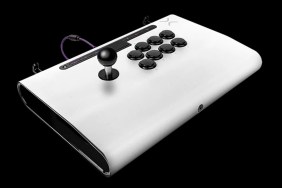Spin city.
While the rest of us were busy playing pool, someone authorized rebranding the lighthearted leisure activity of Ping Pong as the suddenly mature and competitive Table Tennis. Considering the game is mostly played in the basements of frat houses as a means to get chicks drunk enough to maybe show their boobs before passing out, it’s a little hard to take seriously. Unless you’re competing for Phi Kappa stud honors, broseph. GO BEARS!
It was equally difficult to take Rockstar seriously when they announced that their first entry into the next-gen arena would be a Ping Pong *sigh* Table Tennis game. We became doubly alarmed when news arrived that you couldn’t shoot balls out of a rocket launcher or beat hookers to death with your paddle. Something got into Rockstar San Diego’s Kool-Aid, and it definitely wasn’t cheap beer.
[image1]But to their credit, the company has produced a fairly respectable sports game in their debut effort. Although it unfortunately hits a backspin in terms of depth and customizability, Table Tennis has the looks and techniques to compete with other 360 sports games. Or at least Pong.
Since anyone with a kindergarten degree already knows how to play Ping Pong, the rules of Table Tennis aren’t hard to follow. You just hit the ball back and forth, which can actually be a fair bit of fun thanks to the flexible control scheme and fast pace. The face buttons and the right stick interchangeably determine the four shot/spin types (top, back, left and right), and though the face buttons would seem more intuitive to a seasoned gamer, the right stick is actually preferable because you don’t have to think about your shots; simply flick it right for right spin or flick it up for top spin. Natch.
Charging up shots increases spin intensity and fills up a Focus meter that can either be spent on power-shots or saved up for a short window of particularly hard hitting. On the backhand, it also leads to a somewhat tricky aiming/movement issue. The left stick controls both player movement and ball aiming; trying to aim left might also move your player left a bit, which can put you out of position quickly. Plus, the player movement is a little sluggish; it takes time getting comfy with the setup.
[image2]A small colored ring indicating spin surrounds the ball as it’s whacked to and fro. You can then hit the ball back with the same spin type to produce ‘counterspin’, which is theoretically the safest way to return a ball, though the intended effect seems pretty negligible in practice. More often than not, the best course of action is to hit the ball where the opponent isn’t.
Table Tennis’ greatest strength is its excellent feel. As this is essentially a game of tennis on a tiny court, knowing how hard to hit the ball is the real key to success. In that regard, the game offers a cool rumble function that tells you if your wind-up is getting too strong and will result in a long missed shot. It works well and really ties the gameplay together.
Unfortunately, that’s really all there is to it. A mere two single-player modes are here: Tournament and Exhibition. The only functional difference between them is that Tournaments allow you to unlock clothes, players and venues, but even that falls flat because the game contains no player creation tools at all. Instead, the only playable characters are the eleven fictitious ones that come pre-loaded. They enjoy varying attribute levels, but only four are available at the outset. Again and again you’ll face off against Jesper from Sweden or Liu Ping from China. No matter how you dress that up, it’s a dull approach by current sports game standards.
But that’s nothing next to the omission of any sort of Career mode. You won’t take an amateur through the ranks or take on the world as a pro or gain skills and shots and attributes by performing well in mini-games or, well, anything. You’ll just endlessly play Exhibition and Tournaments against the CPU, which offers generally sufficient competition but hardly enough to justify the lack of a deeper dive.
Once you tire of beating your friends and humiliating robot Jesper, you can hop online and whack away against others. This is probably the best way to go since human opponents mix it up better than the CPU, but other than barebones leaderboards and basic match types, there’s not much to keep you coming back.
[image3]And that’s a shame, because it certainly looks good. Though Table Tennis doesn’t offer much in the way of ambient action or crowd support, the players look great and move fluidly. Only two in-game cameras are here, but a nice replay feature lets you relive hard-fought points from several more angles. When you get a fast rally going, it moves quite quickly thanks to the silky smooth framerate and solid physics.
Other than some cheesy point announcements and what sounds like the most bored crowd ever, the audio is pretty inoffensive. Rockstar is known for their soundtrack work and has opted to throw in a slew of mellow techno grooves. It’s an odd choice for Ping Pong, but then again, Ping Pong is just an odd choice in general.
It’s also a tough one for Xbox 360 owners, though the fact that it retails at the “budget” price of $40 makes it a little easier. With good mechanics and delivery, Table Tennis will certainly keep you and your impoverished frat buddies entranced for a bit, but the profound lack of depth makes it a decidedly hard pledge.
-
Good mechanics
-
Smooth delivery
-
Decreased price
-
Woeful lack of depth
-
Dull single-player
-
Movement/aiming conundrum










